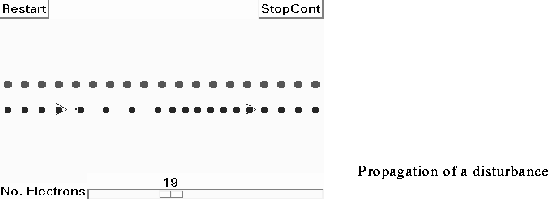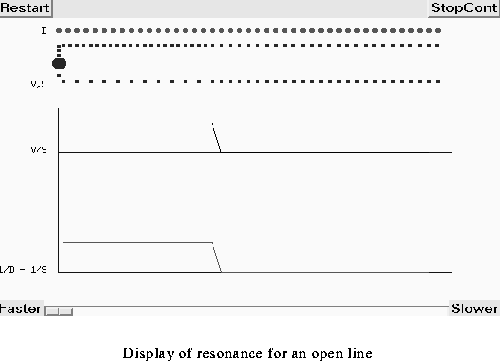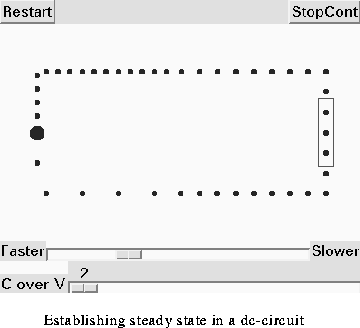Table of Contents
Zvonko Fazarinc
Palo Alto
To the list of Colos applications
elCur1-5 is a set of applications which allow the user to observe delayed interaction of electrons in conductors and to study the associated phenomena. The presentation consists of controllable dynamic graphics diplays which provide means for interactive variation of relevant parameters and for inducement of electron accelerations via voltage or current sources or their equivalents.
elCur1-5 modules are intended to lay the groundwork towards understanding of concepts like capacitance, inductance, reflection, resonance, voltage source, and current source. The individual modules lead from simplest ideas about delayed propagation to understanding of how the net charge travels at velocity of light while individual electrons barely move. They explain how a wire can become positive or negative and eventually lead to understanding of quarter-wave resonance on transmission lines, a concept normally reserved for experts in the field. Reflections at the open or shorted end are brought to an intuitive comprehension and the build-up of voltage in a capacitor driven by a current source or a built up of current in an inductor driven by a voltage source free themselves from abstract notions. The final module which is a full-fledged simulation of a transmission line extends the gained comprehension into additional behaviours that are better served by a mathematical model but without introducing any new abstractions.
The mathematical model that is used to study these phenomena in traditional courseware introduces from the very beginning the unexplained notions of voltage and current, inductance and capacitance and answers only those questions that can be derived from such a model. The approach taken by elder modules is to understand these notions from observing the motion and interaction of electrons based on first principles of nature, in this case Coulomb's law, relativity and conservation of momentum. The ideas of voltage and current are presented in terms of electron spiciness and velocities and do as such rely on intuitive comprehension of these mechanical concepts.
The groundwork laid in those terms can then be used to derive the mathematical model.
The didactical approach can be summarized as \xe3 using the physical understanding to derive the mathematical model rather than using the model to gain understanding".
The first three modules present a linear array of electrons of which one can be accelerated by the user. The disturbance associated with the acceleration which propagates in all directions is shown and the delayed effect on adjacent electrons can be seen when the disturbance reaches them.

The disturbance propagates at constant velocity regardless of the motion status of accelerated electrons. This is the extent to which one must accept the principle of relativity and it appears so obvious on the screen that nobody questions it. Barriers to motion can be induced and the accumulation due to delayed interaction can be observed. In this manner the notion of capacitance and inductance is developed.
The fourth module shows electrons arranged along two wires connected by a voltage source and the learned phenomena in positive and negative wires are put together for a convincing resonance display.

It takes four passes along the wires for the sequence to repeat and the quarter-wave resonance is brought to light.
The final module is a complete transmission line simulation on which the same phenomena can be induced in a more versatile manner.

Initially the modules are intended to be used by the teacher in introductory courses on conduction of electricity. Eventually in an electronic book environment the modules could be used for self-study. Narrated by the author a presentation suitable for video-taping could be generated that could be used in secondary schools.
The modules are not complete yet but they have been demonstrated to colleagues in the lab in order to get feedback on presentational issues. The electronic book concept seems to be a very natural way for tying the five modules together with "manuals" written around them in the form of a book text. This will be tried as the next step.
